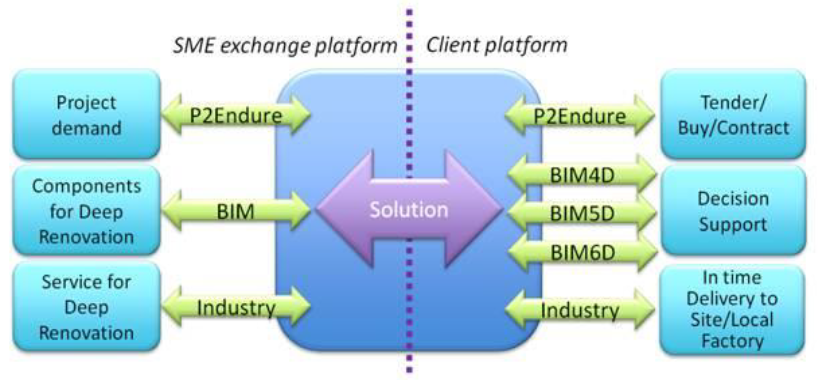D2.5: Set-up of an e-Marketplace
Summary
The findings documented in this deliverable are relevant for the development of the demonstrator of the e–Marketplace. P2ENDURE offers a holistic solution differing from competitors. The draft of the platform is designed to collect and filter information based on BIM models in order to support the buying, prefabrication and making processes related to building components for deep retrofitting.
Furthermore the involvement of different stakeholders is organised at an easy–to-handle level and the efficient and effective communication about projects’ details is realised. The realisation and production of the operating platform including the involvement of important stakeholders as the building supply industry is not foreseen in P2ENDURE. Nevertheless, the analysis of applicable business models shows promising opportunities for a later start-up business. This is following current multi-channel distribution ideas discussed currently with growing acceptance in the building supply industry.

Figure 1: scheme P2ENDURE e-Marketplace, ©3L
Nevertheless the added value of the P2ENDURE e-Marketplace for different stakeholders from real estate developers, designers, engineers, building owners to construction companies is the key to a successful and sustainable implementation. The USP of the platform is the holistic offer including the preparation of a localised pre-fabrication from the perspective of the above mentioned members of the group of stakeholders.
Chapter 2 - Analysis of the Existing Platforms summarises the generic scope of the deliverable giving an insight in current developments in market diffusion strategies of the construction market developed or demanded by the building supply industry. It contains the idealistic benefits survey of a BIM based platform for all stakeholders. The vision is the ‘Building Amazon’ a holistic platform operating in the field of building supply and retrofitting. The demonstrators’ values and its benefits for all market partners are described. This section introduces e-Marketplaces and its functionalities in general, the difference between e-Marketplace and e-commerce, and reasons for their late adoption in the construction industry. Additionally, chapter 2 offers an overview of the initiatives undertaken in EU projects aiming at fostering the transition to e-Marketplaces at many levels and in several industries. Such initiatives include PaaSport, MOBiNET, WaterInnEU, AppHub, AutoMat, and Proficient. Lastly, section 2 identifies possible e-Marketplace models that could be suitable to the needs of P2ENDURE.
Chapter 3 - Expected Functionality Of The e-Marketplace is focusing on the impact and interaction of the P2ENDURE platform created by stakeholder needs. The interaction is organised from two different sides following the client and the SME driven demands. The partners from the building supply industry are involved in service and logistics. The current demand of the single project is identified by the precise project data and the qualified identification of needed components by filtering of BIM data.The platform allows tendering, buying and contracting on basis of the available information. It gives a decision support for the client based on time, costs and facility management aspects and helps to organise the site logistics including pre-fabrication at the local factory.
Chapter 4 is giving an insight on the BIM based holistic and systemic approach. The P2ENDURE e-Marketplace is characterized by the integration of different components into one system. Six steps were shown for describing the system. First, the user loads his ‘as is BIM’ model into the front-end display of the P2ENDURE e-Marketplaces. In the second step, this model is presented in the front end of the e-Marketplaces. In addition to the ‘as is BIM’ model the user is also shown the energy and thermal data of his model. The e-Marketplace products which can be used for the renovation are also shown in the front-end display. In the third step, the user can add these products to his ‘as is BIM’ model. In the subsequent process step a new calculation of the thermal and energy data is carried out. The parameters of the selected products are added to the original ‘as is BIM’ model data (process step 5). Finally, the calculated data are displayed again in the front-end of the P2ENDURE e-Marketplaces. Using these data, the user can easily identify the thermal and energetic potential (and cost savings) of the renovation.The P2ENDURE e-Marketplace with the integrated parametric modeller offers the user the possibility to calculate his renovation project energetically. The result of the calculation reflects a comparison of the existing values and the new values.
For this purpose, product solutions are made available within the e-Marketplaces. As already indicated (chapter 4.1.3), these individual products must be described as precisely as possible by the manufacturers. This information includes, for example, product prices, design parameters and (where applicable) maintenance values. Without the description of the products, they cannot be implemented in the P2ENDURE e-Marketplace.
Chapter 5 introduces the local factory organization integrating the P2ENDURE 4M approach as part of the e-Marketplace. A generic four step implementation plan is elaborated that can be adapted according to the district characteristics and defined requirements for the production of specific PnP solutions. Furthermore, this section gives an insight in the potential value and sustainability aspects that are achieved by local factory concept integration.
Download